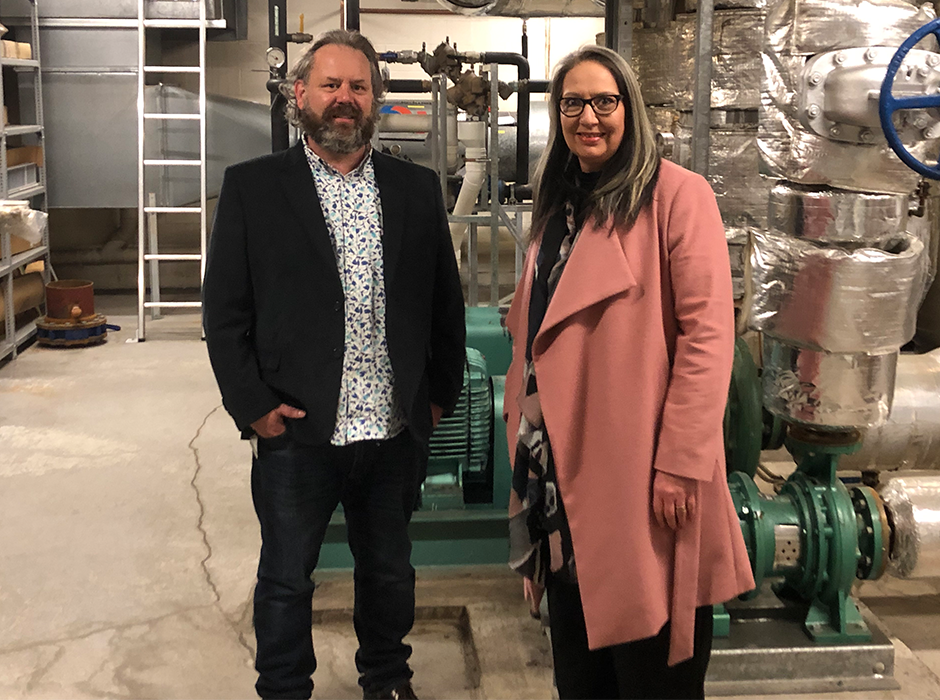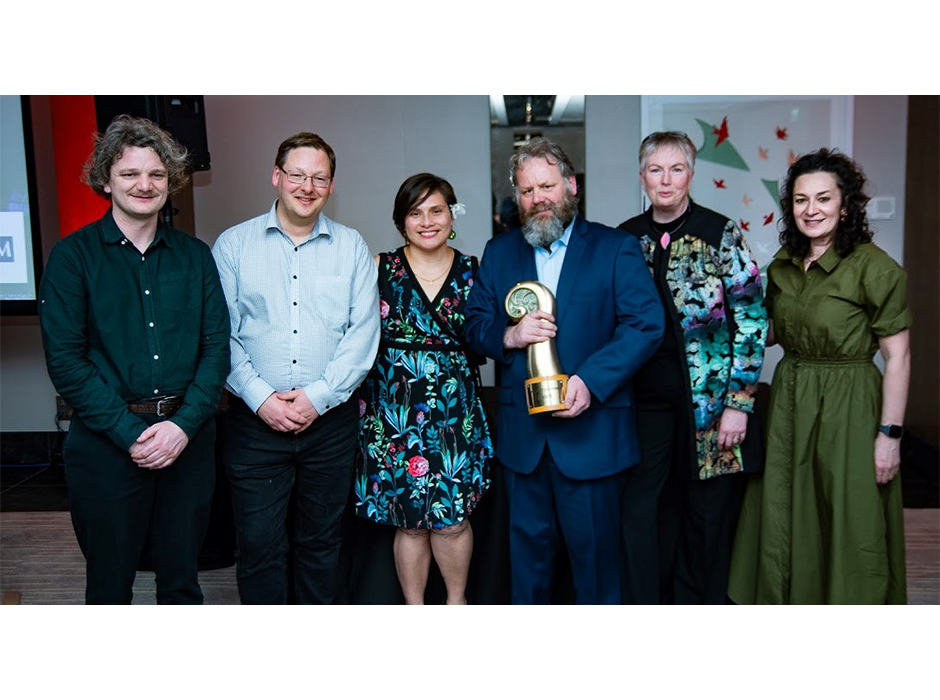
Energy and Building Controls Manager Shane Jenkins with energy analytics project manager Ria van den Berg in the basement of the Information Services Building.
Being the first University nationwide to manage buildings’ daily energy use with large-scale artificial intelligence analytics is saving more energythan expected.
Energy and Building Controls Manager Shane Jenkins says there was a 15 per cent reduction in energy-related costs across seven Dunedin campus buildings during the first year of using the new system. The buildings were selected for their substantial energy usage, diverse energy sources, or long occupancy hours.
Energy costs the University $22-$25 million every year so gaining insights into buildings’ energy use in real time to identify issues – then setting targets for improvements and tracking progress – can have huge impacts, Shane says.
“We’re a really small energy team of three doing a really big job with a portfolio of about 395 buildings across the country and a focus on the sustainable operation of our University. That’s not just from a cost and environmental point of view, that’s about making sure our University’s still here in another 150 years,” Shane says.
The Kaizen Fault Detection and Diagnostics System, and data analytics software from Canadian energy management company CopperTree Analytics, paid for itself in two years, and continues to cover its annual fee.
Added bonuses
Using analytics to save energy also reduces the University’s emissions and carbon footprint, Shane says.
Trades and facility management staff can also use the system to identify and fix problems, meaning less reactive maintenance such as shutting down areas or working at night.
The initial buildings analysed were Mellor Laboratories, the Faculty of Dentistry, the Information Services Building, Otago Business School, the William James building, St David II, and the Lindo Ferguson building.
This year, the system will be implemented in Te Rangihīroa College, the Plaza Building, and the Eccles Building.
How it works
The system gathers information from our Building Management Systems (BMSs) – which monitor and control heating, cooling, and ventilation by collecting data through about 100,000 controllers – then provides real-time analytics.
That is game changing because our University has one of the largest and most diverse range of Building Management Systems in Australasia, ranging from 30-40 years old to brand new, Shane says.
What it does
The system introduced about two years ago identifies high consumption or anomalies and sends staff ‘insights’, including suggestions on possible causes, allowing staff to resolve the issues to optimise energy use.
“It makes more work for us, but it’s good work,” Shane says.
The system can pinpoint when people adjust thermostats incorrectly, when building controls are manually overridden then not re-automated, and if mechanical faults mean spaces are being simultaneously warmed and cooled.
When the analytics spotted a wai (water) chilling system cycling on and off more than expected – every start uses about six to seven times more energy – the system’s suggestions included checking the temperature sensor, the chiller being too big, and the water being chilled too much.

With Otago’s Energy Analytics programme award at the Tertiary Information and Communications Technology (ICT) Excellence Awards in Auckland last year are (from left), Reuben Henderson, Paul van Tuel, Christina Mualia-Lima, Shane Jenkins, Nicola Walmsley, and Leah McKay.
Staff discovered the controls needed tweaking and put that information into the analytics system so its knowledge database “keeps getting better and better”, Shane says.
Analytics also show which systems do not switch off as programmed after people have left rooms and when space use changes – for example, when a laboratory becomes a teaching space.
Real-time updates enable energy staff to adjust hot-water cylinders and other heating to reduce energy use during spikes, without people noticing any difference.
The system can produce reports on everything from real time energy use to carbon emissions, comfort levels in rooms and bespoke data on specific areas for specific reasons.
Shane credits Chief Operating Officer Stephen Willis with spotting the opportunity for analytics then advocating for them, and Project Manager Ria van den Burg with implementing the system, in partnership with many areas around the University.
The background
A wider programme of work supported introducing analytics, including upgrading the BMSs in significant buildings between 2020 and 2023. More upgrades are planned, Shane says.
Those updated BMS were also integrated with room booking systems so staff no longer have the time-consuming task of adding those manually. The BMS were also linked to lighting, audio-visual systems, and access so they can be monitored and controlled.
Integrating the analytics with the Internet of Things has enhanced staff knowledge. For example, sensors in buildings without BMS can now measure air quality so it can be improved, while water use is calculated by reading underground tobies remotely in real time so water leaks are spotted immediately, Shane says.
Award-winning
Otago’s energy analytics programme was the supreme winner at the Tertiary Information and Communications Technology (ICT) Excellence Awards in Auckland late last year. It also won the Excellence in Technology Innovation Award.
Using analytics to make buildings more efficient is also backed up by new research from Otago Energy Programme academics who say rather than pushing for large-scale uptake of rooftop solar power, New Zealand needs to focus on improving our building stock’s energy efficiency as quickly as possible.
Energy and Building Controls is part of the Operations Group, which has three top priorities:
Enable – the University to achieve its visions and mission.
Engage – with students, each other, customers and externally.
Experience – of students, customers, and externally to be outstanding.